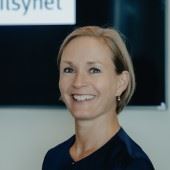Time for generative AI in the sandbox
Large language models have taken society by storm in the past year. It is also reflected when the Norwegian Data Protection Authority has now selected four new projects for exploration in the regulatory sandbox.
Large language models have taken society by storm in the past year. It is also reflected when the Norwegian Data Protection Authority has now selected four new projects for exploration in the regulatory sandbox.
It is now clear which projects will be included in the fifth round of the sandbox. From the 20 applications received, the admissions committee has worked diligently to select the best projects - seen from a learning perspective.
 - There was no plan or strategy to specifically choose projects related to language models and generative AI. The aim was primarily to find good projects that address important privacy-related challenges associated with innovation and digitalisation, says Eirik Gulbrandsen, who has chaired the admissions committee.
- There was no plan or strategy to specifically choose projects related to language models and generative AI. The aim was primarily to find good projects that address important privacy-related challenges associated with innovation and digitalisation, says Eirik Gulbrandsen, who has chaired the admissions committee.
Nevertheless, generative AI became a common thread, and there could potentially be fruitful learning along the way across the projects.
The admissions committee landed on three projects that all explore generative AI, but with different approaches. The projects come from NTNU, the Directorate of Health and the firm Juridisk ABC.
- The selected projects were well substantiated, with well-defined issues and goals for a sandbox project. All the projects have potential for learnings useful to many, says Gulbrandsen.
NTNU wants to find out how the public sector should deal with just that. In the sandbox, they will be able to explore whether and how they and other public enterprises can use Microsoft's 365 Copilot.
The Directorate of Health wants to explore whether generative AI can be used to make information from the healthcare system more adapted and understandable for different user groups, including with a focus on children and young people.
The third project, Juridisk ABC, will use generative AI for legal advice related to employment law.
 – These are projects that involve a lot of sensitive personal data. So this will be important and exciting to be part of. Here, both the participants, the Norwegian Data Protection Authority and the rest of society will learn a lot, says Norwegian Data Protection Authority director Line Coll.
– These are projects that involve a lot of sensitive personal data. So this will be important and exciting to be part of. Here, both the participants, the Norwegian Data Protection Authority and the rest of society will learn a lot, says Norwegian Data Protection Authority director Line Coll.
The NTNU project can have significant transfer value to others, as it deals with software with integrated AI bought off the shelf, and use of this in the public sector.
- Now the integrated generative artificial intelligence is coming full circle. This means that it is not an AI tool that you have specifically chosen, but that it is built into platforms and programs that you otherwise use. This is where most people will come across generative AI in everyday life going forward, Gulbrandsen explains.
In addition, the Norwegian Data Protection Authority has selected a fourth project, from Ahus. It does not involve artificial intelligence, but with the sandbox's new and expanded mandate, which also includes "normal" digitalisation, there will be room for such projects. They want to simplify data sharing in the healthcare system, and develop a scheme for age-appropriate relative login, also called a digital power of attorney scheme. This can also have general transfer value to other types of services, e.g. financial.
- This project is in an early phase, and some basic clarifications are needed before we can get to the most exciting discussions and assessments from a privacy perspective. Therefore, this project will have a longer project run, a sort of long-term sandbox project, says Gulbrandsen.
Regulatory sandboxes are a guidance method especially intended for projects at the forefront of their field, where there is little legal practice to refer to. And director Coll believes that both the pile of applications and the selected projects show that the sandbox is well suited to absorb early trends.
- These are great and important projects. Both (generative) artificial intelligence and children's and young people's privacy are key focus areas for the NDPA in 2024. So we look forward to the results of these sandbox projects, says Coll.